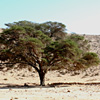Acacia gerrardii is a thorny desert tree, which reaches a height of 3-9 meters. It grows on a single trunk or splits into 2-4 thick trunks near its base. The bark of the trunk is gray-reddish, cracks along its length and peels in scales. The leaf is bipinnate with glabrous leaflets 7 mm long. There are green glands in the branching of the leaf axis which secrete a sweet material that attracts ants. There is a pair of white, conical, straight and aggressive thorns at the base of the leaf, some of which are short and some long. Those who drive their cars in the desert know that they should not pass under Acacia trees, because the thorns of branches that fell can puncture tires. The tree sheds its leaves between September and December.
Acacia gerrardii blooms between June and December, mainly in October and November. The flowers are grouped into spherical capituli with a diameter of 10 mm. Each capitulum contains dozens of bisexual flowers, but usually only one of them ripens into a fruit. The flowers are tiny, without a corolla, and the stamens give them their whitish color. The flowers have nectar and pollen, and insects of different orders are among the pollinators – bees, wasps, flies and beetles. The flowers are apparently also pollinated by wind. The fruit is narrow and compressed, arched like a banana or horseshoe, but is not bent into a ring or spiral. Initially it is green to purple, and later turns brown. The seed is lenticular, brown, smooth, with a diameter of 3 mm.
Acacia gerrardii grows in ravines in the desert, mainly in the southern Negev. It is more resistant to cold than other Acacia species. The plant is protected by law. Its global distribution is in East Africa.
The genus Acacia contains 750 species, half of which grow in Australia and the islands of the Pacific Ocean.
Written by Mike Livne




